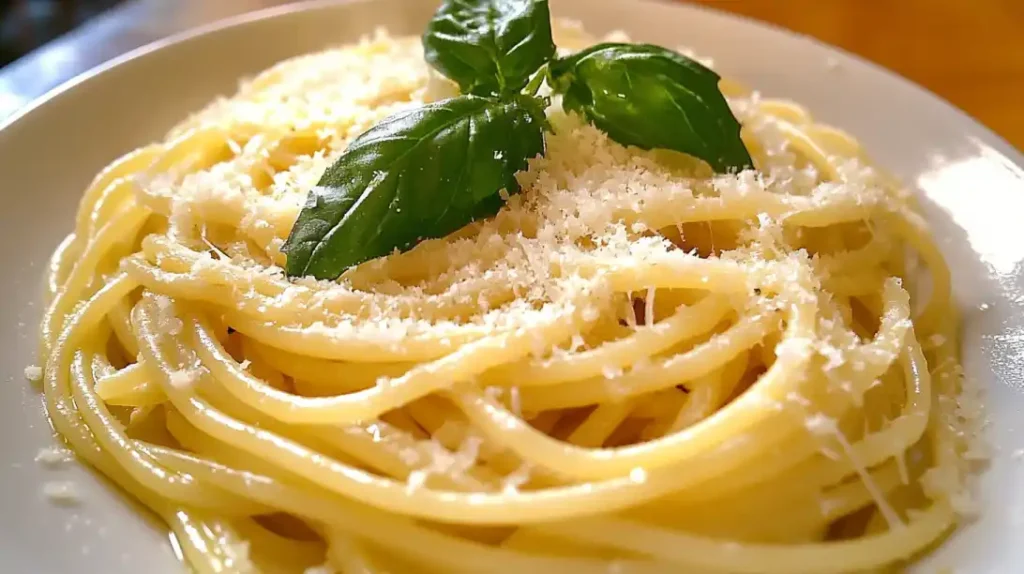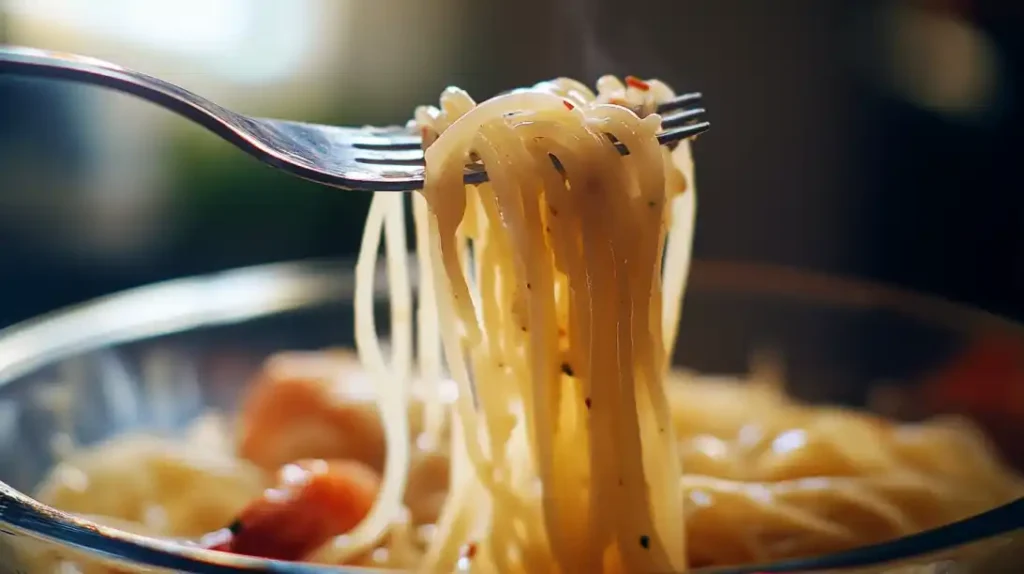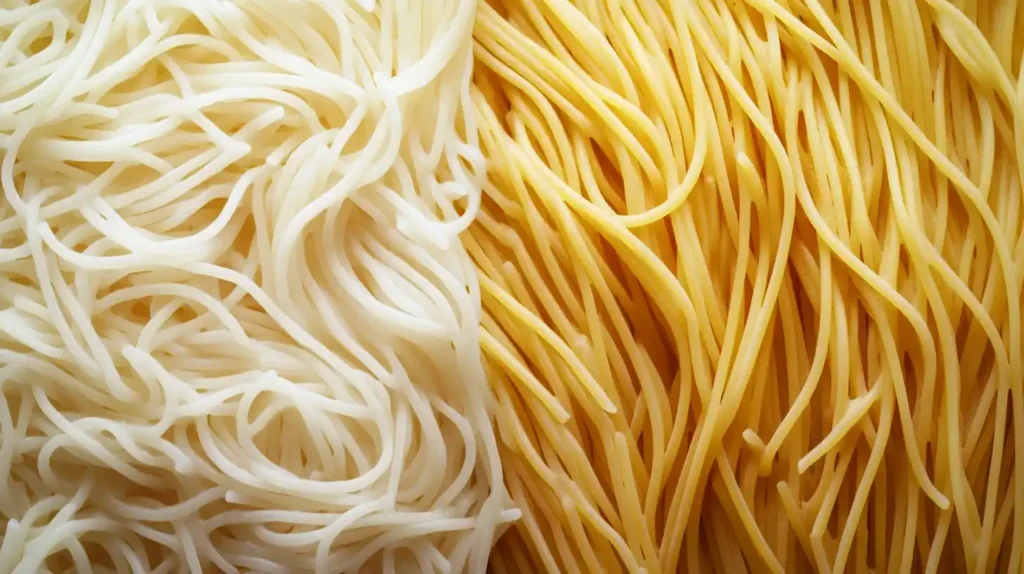Spaghettini may look similar to spaghetti, but it is noticeably thinner. This delicate pasta cooks faster and absorbs flavors differently. While spaghetti pairs well with hearty, meat-based sauces, spaghettini shines in dishes where the pasta itself is the highlight. Is Spaghettini like angel hair pasta? Although spaghettini is thinner than traditional spaghetti, it is still slightly thicker than angel hair pasta. Angel hair, or capellini, is the finest of the three, making it ideal for light, delicate sauces such as olive oil, garlic, or simple tomato-based dressings. Spaghettini, on the other hand, offers a slightly more substantial bite while still maintaining a light texture, making it versatile for various dishes. If you’re looking for more meal inspiration, check out these quick halal meals you can make anytime.
Table of contents
- What Is Spaghettini? (Spaghettini vs angel hair)
- What Is Angel Hair Pasta? (Angel hair vs spaghettini)
- Similarities Between Spaghettini and Angel Hair Pasta
- Key Differences Between Spaghettini and Angel Hair Pasta
- How to Cook Each Type of Pasta
- FAQs About Spaghettini and Angel Hair Pasta
- Which One Should You Choose?
- Conclusion
What Is Spaghettini? (Spaghettini vs angel hair)
Origins of Spaghettini
To answer the question, is Spaghettini like angel hair pasta, we need to start by understanding what Spaghettini is. This thinner version of spaghetti is slightly thicker than angel hair pasta. It pairs beautifully with tomato-based sauces, olive oil, and even seafood. While they may share a resemblance, Spaghettini offers more bite and substance.

How Spaghettini Differs From Spaghetti (thin pasta comparison)
Although it looks similar to spaghetti, spaghettini is noticeably thinner. This smaller size means it cooks faster and absorbs flavors differently. While spaghetti is better suited for hearty, meat-based sauces, is spaghettini like angel hair pasta? Spaghettini thrives in recipes where the pasta takes center stage, offering a delicate texture that pairs well with lighter sauces and fresh ingredients.
Ideal Sauces for Spaghettini
Choosing the right sauce is key to making the most of spaghettini. Here are some top choices:
- Light Tomato Sauces: Think marinara or pomodoro simple and fresh.
- Oil-Based Sauces: Garlic, olive oil, and chili flakes create a classic aglio e olio.
- Herb-Forward Sauces: Basil pesto or parsley gremolata works beautifully.
Popular Spaghettini Dishes
You’ll find spaghettini featured in various cuisines beyond Italy, but it’s especially beloved in Mediterranean cooking. A few popular dishes include:
- Spaghettini Aglio e Olio: Pasta tossed with olive oil, garlic, and chili.
- Spaghettini with Prawns: A light seafood dish often complemented with lemon zest.
- Lemon Butter Spaghettini*: Perfect for summer, combining fresh citrus flavors with creamy butter.
Cooking Tips for Perfect Spaghettini (spaghettini uses)
- Use Enough Water: Boil plenty of salted water to ensure the pasta cooks evenly.
- Don’t Overcook: Check for doneness after 6 minutes to keep it al dente.
- Toss Immediately: Drain and mix with sauce while it’s hot to prevent clumping.
With these details, you’re ready to incorporate spaghettini into your meals like a pro.
What Is Angel Hair Pasta? (Angel hair vs spaghettini)
Have you ever asked yourself, is Spaghettini like angel hair pasta? While they may look similar, these two types of pasta are quite different. Both are thin and long, but their unique characteristics make them ideal for different recipes. Understanding these differences ensures your dishes turn out perfectly.

Key Features of Angel Hair Pasta
- Thickness: Extremely thin, typically between 0.85 and 0.92 mm in diameter.
- Cooking Time: Cooks in just 2–3 minutes, which is ideal for quick meals.
- Best Pairings: Perfect with light sauces, especially creamy or seafood-based ones.
Why Choose Angel Hair Pasta? (angel hair vs spaghettini)
Is Spaghettini like angel hair pasta? This pasta is a go-to for dishes where the focus is on delicate flavors and smooth textures. Because it’s so thin, it doesn’t overpower the other ingredients. Instead, it complements light sauces and toppings like vegetables or shrimp.
Similarities Between Spaghettini and Angel Hair Pasta
So, is Spaghettini like angel hair pasta in any way? Yes, they do share some similarities. Both are thin, long pastas that cook quickly and work well with light sauces. However, their subtle differences in thickness affect how they feel in a dish and what sauces work best.
Shared Characteristics
- Shape and Length: Both are slender, cylindrical strands that look like thinner versions of spaghetti. Their long shape makes them perfect for twirling on a fork.
- Quick Cooking Time: Both pastas cook faster than thicker varieties like fettuccine or rigatoni. This makes them great options when you need a quick meal.
- Ideal for Light Sauces: Due to their delicate texture, both types pair well with light sauces such as olive oil, garlic, or seafood-based options.
- Versatility: Both pastas are versatile enough to be used in soups, salads, or as a side dish.
How They Complement Similar Dishes (angel hair vs spaghettini)
Both spaghettini and angel hair pasta shine in dishes where the sauce isn’t too heavy. For example:
- Light tomato sauces like marinara or pomodoro enhance the subtle texture of the pasta.
- Creamy or buttery sauces cling beautifully to the thin strands.
- Oil-based sauces highlight their smoothness without overpowering their flavor.
Perfect for Quick Meals
Is Spaghettini like angel hair pasta? If you’re short on time, either spaghettini or angel hair pasta is a great choice. With both cooking in under 10 minutes, they’re perfect for whipping up something tasty and satisfying when you’re in a rush.
Key Differences Between Spaghettini and Angel Hair Pasta
If you’re still asking, is Spaghettini like angel hair pasta, here’s where the differences become clear:

- Thickness: Spaghettini is thicker, providing a firmer texture.
- Cooking Time: Angel hair pasta cooks much faster, in just 2–3 minutes.
- Sauce Pairings: While Spaghettini works well with heartier sauces, angel hair pasta is ideal for delicate ones.
Thickness
- Spaghettini: Slightly thicker, with a diameter of 1.5 to 1.8 mm. It has a firmer bite, making it more substantial.
- Angel Hair Pasta: Extremely thin, ranging from 0.85 to 0.92 mm in diameter. Its delicate nature gives it a softer texture.
Cooking Time
- Spaghettini: Takes about 6–8 minutes to cook. It’s forgiving if left in the water a bit longer.
- Angel Hair Pasta: Cooks in just 2–3 minutes. Overcooking can lead to mushy strands, so it requires close attention.
Best Sauce Pairings
The sauces you choose can make or break a dish. Here’s how each pasta shines with different flavors:
- Spaghettini: Its thicker strands hold up to slightly heavier sauces like:
- Tomato-based sauces (e.g., marinara or arrabbiata).
- Pesto for a herby and fresh flavor.
- Garlic and olive oil for a classic, simple dish.
- Angel Hair Pasta: This pasta’s lightness complements delicate sauces such as:
- Creamy sauces (e.g., Alfredo or lemon butter).
- Seafood-based sauces (e.g., shrimp scampi).
- Light vegetable toppings like cherry tomatoes or asparagus.
Dish Pairing Suggestions
- Choose spaghettini for recipes where you need a bit more texture and bite. For example, try it with rich tomato sauce and Parmesan.
- Opt for angel hair pasta when you want an elegant, light dish like shrimp in garlic butter sauce or a summer vegetable medley.
How to Cook Each Type of Pasta
Is Spaghettini like angel hair pasta? Cooking spaghettini and angel hair pasta may seem simple, but a few techniques can make a big difference. Both types are quick to prepare, but they require different levels of attention due to their thickness.
How to Cook Spaghettini
- Boil Plenty of Water: Use a large pot with enough water to let the pasta move freely. Add salt generously for flavor.
- Cook for 6–8 Minutes: Stir occasionally to prevent clumping. Test for doneness after 6 minutes to keep it al dente.
- Drain and Toss: Quickly drain and toss the pasta with your sauce while it’s still hot. This ensures the flavors coat the strands evenly.
Best Practices for Spaghettini*
- Pair with slightly thicker sauces like tomato or pesto for the best results.
- Use it as a base for dishes with grilled vegetables or light proteins like chicken or shrimp.
How to Cook Angel Hair Pasta
- Use a Wide Pot: Since it’s very thin, angel hair pasta can clump easily. Boil in a pot with lots of water to avoid this.
- Cook for 2–3 Minutes: Watch closely because it cooks quickly. Taste frequently to ensure you don’t overcook it.
- Toss Immediately with Sauce: Drain the pasta quickly and mix it with sauce right away to prevent sticking.
Best Practices for Angel Hair Pasta*
- Pair with delicate sauces like lemon butter or a garlic and olive oil mixture.
- Use it in lighter recipes, such as a seafood pasta or summer vegetable medley.
Common Mistakes to Avoid
- Overcooking: Especially with angel hair pasta, a few extra seconds can lead to mushy strands. Always taste-test before draining.
- Not Tossing with Sauce Immediately: Thin pastas like these can clump together if left dry for too long. Toss with sauce as soon as you drain them.
FAQs About Spaghettini and Angel Hair Pasta
Here are some frequently asked questions about spaghettini and angel hair pasta. These answers will help you better understand when and how to use each type in your cooking.
Are Spaghettini and Angel Hair Pasta the Same?
No, they are not the same. While both are thin, long pastas, spaghettini is thicker and has a firmer bite. Angel hair pasta is much thinner and softer, making it better suited for light and delicate sauces.
Can I Use Spaghettini Instead of Angel Hair Pasta?
Yes, you can substitute spaghettini for angel hair pasta in most recipes. However, keep in mind that spaghettini will have a firmer texture and take longer to cook. It’s also better suited for slightly richer sauces compared to the delicate nature of angel hair pasta.
What’s a Good Substitute for Angel Hair Pasta?
If you don’t have angel hair pasta, you can use:
- Capellini: It’s almost identical in thickness.
- Thin spaghetti: Slightly thicker but still works in most recipes.
- Spaghettini: A bit thicker but still a suitable alternative.
Which Sauces Pair Best with Each Type?
- Spaghettini: Tomato-based sauces, pesto, or garlic and olive oil.
- Angel Hair Pasta: Creamy sauces, seafood-based sauces, or simple lemon butter.
What’s the Best Way to Avoid Clumping When Cooking These Pastas?
- Use plenty of boiling water to give the pasta room to move.
- Stir frequently, especially in the first few minutes of cooking.
- Toss the pasta with sauce immediately after draining.
Which One Should You Choose?
Choosing between spaghettini and angel hair pasta depends on the type of dish you want to create. Both pastas have their strengths, but understanding their differences will help you make the best choice.
When to Choose Spaghettini
- If You Want More Bite: The slightly thicker strands of spaghettini offer a firmer texture. It’s ideal if you enjoy pasta with a bit more chew.
- For Heartier Sauces: Spaghettini pairs beautifully with rich tomato sauces, creamy pesto, or olive oil-based recipes that require the pasta to hold up to the weight of the sauce.
- In Versatile Dishes: This pasta works well in everything from light summer salads to hearty dinners with grilled chicken or vegetables.
When to Choose Angel Hair Pasta
- If You Prefer Delicacy: With its ultra-thin strands, angel hair pasta has a light, elegant texture. It’s perfect for dishes where the pasta takes a backseat to delicate toppings or sauces.
- For Light Sauces: Use angel hair pasta with buttery, seafood-based, or lemony sauces that coat the strands without weighing them down.
- For Quick Meals: Its short cooking time makes it a lifesaver when you need to prepare something delicious in minutes.
Key Considerations
- The Sauce: Heavier sauces work better with spaghettini, while light, delicate sauces pair best with angel hair pasta.
- Cooking Time: If you’re short on time, go for angel hair pasta. Its 2–3 minute cooking time can be a game-changer.
- Dish Texture: Decide whether you want a firmer, heartier bite (spaghettini) or a soft, delicate texture (angel hair pasta).
Quick Guide to Choosing
| Dish Type | Best Pasta |
|---|---|
| Rich tomato-based sauces | Spaghettini |
| Creamy or seafood sauces | Angel Hair Pasta |
| Light summer salads | Angel Hair Pasta |
| Hearty winter dishes | Spaghettini |
By considering your sauce, cooking time, and texture preferences, you can confidently choose the right pasta for your recipe. Whether you’re hosting a fancy dinner or cooking a quick weekday meal, both pastas can elevate your dish in unique ways.
Conclusion
Is Spaghettini like angel hair pasta? Spaghettini and angel hair pasta may look alike, but their differences can significantly impact your cooking. Understanding when to use each pasta type ensures your dishes turn out exactly as you want them to be.
Quick Recap
- Choose spaghettini if you want a firmer texture or are using slightly heavier sauces like tomato or pesto.
- Opt for angel hair pasta if you need something delicate that works well with light, creamy, or seafood-based sauces.
Both pastas are versatile and quick to cook, making them perfect for a wide range of recipes. However, the key is to match the pasta’s characteristics with the sauce and texture you want in your dish.
Final Thought
So, is Spaghettini like angel hair pasta? The answer is no, they are not the same, but they complement similar dishes in unique ways. Whether you prefer the firmer bite of Spaghettini or the delicate texture of angel hair pasta, understanding their differences will make your meals more enjoyable.

